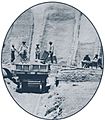Guano facts for kids
Guano is a special kind of poop from bats and birds. It's super rich in important stuff like nitrogen, phosphate, and potassium. These are like superfoods for plants! Because of this, guano is often used as a fertilizer to help plants grow bigger and faster.
Contents
What is Guano?
Guano is basically the waste left behind by large groups of bats or birds. Over many years, this waste builds up in places like caves (for bats) or on islands (for birds). It becomes a thick, powerful natural fertilizer. People have been using guano for hundreds of years to help their crops grow.
Why is Guano So Special?
The reason guano is such a great fertilizer is because of what's inside it. It has a lot of nutrients that plants need to be healthy.
- Nitrogen: Helps plants grow strong leaves and stems.
- Phosphate: Important for roots, flowers, and seeds.
- Potassium: Helps plants stay healthy overall and resist diseases.
These nutrients are like vitamins for plants, making them grow much better than they would without them.
Where Does Guano Come From?
Guano is mostly found in places where many bats or birds live together for a long time.
Bird Guano
Many seabirds, like Guanay cormorants and Peruvian boobys, live in huge colonies on islands near the coast. Their droppings pile up over centuries, especially in dry climates where rain doesn't wash it away. Places like the Chincha Islands off the coast of Peru were famous for their massive guano deposits.
Bat Guano
Bats often live in large groups inside caves. Their droppings fall to the cave floor and can build up into huge piles. This bat guano is also full of nutrients and is collected from caves around the world.
History of Guano Use
People have used guano for a very long time. Ancient civilizations, like the Incas in South America, knew how valuable it was. They even had strict laws about collecting and protecting the birds that produced it.
Guano Rush
In the 1800s, there was a huge demand for guano, especially in Europe and North America. Farmers needed good fertilizers to grow more food. This led to a "Guano Rush," where ships traveled all the way to islands like the Chincha Islands to collect the valuable fertilizer. It was hard work, with laborers digging and loading the guano onto ships. Many countries even fought over who had the right to collect guano from certain islands!
Guano Today
Even today, guano is still used as a natural fertilizer. It's especially popular in organic farming because it's a natural product and not made with chemicals. It helps improve the soil and gives plants the nutrients they need to thrive.
Animals That Depend on Guano
Guano isn't just good for plants; it's also important for some animals! In caves, bat guano provides food for many insects, like cave cockroaches. These insects then become food for other animals, like the Ozark cavefish. So, guano helps create a whole food chain in cave environments.
Images for kids
-
The nest of the Peruvian booby is made of almost pure guano.
-
The Guanay cormorant has historically been the most important producer of guano.
-
Man-made Guano Island near Walvis Bay in Namibia
-
Aerial view of Guano Point. Old tramway headhouse is at the end of dirt road (right). Second tramway tower is more clearly visible, on skyline to right. Bat Cave mine is 760 m (2,500 ft) below, across the canyon.
-
The Ozark cavefish, a species that depends on bat guano as a source of food.
See also
 In Spanish: Guano para niños
In Spanish: Guano para niños












